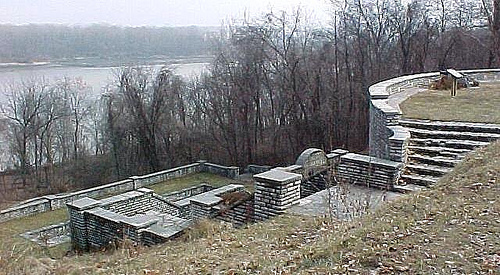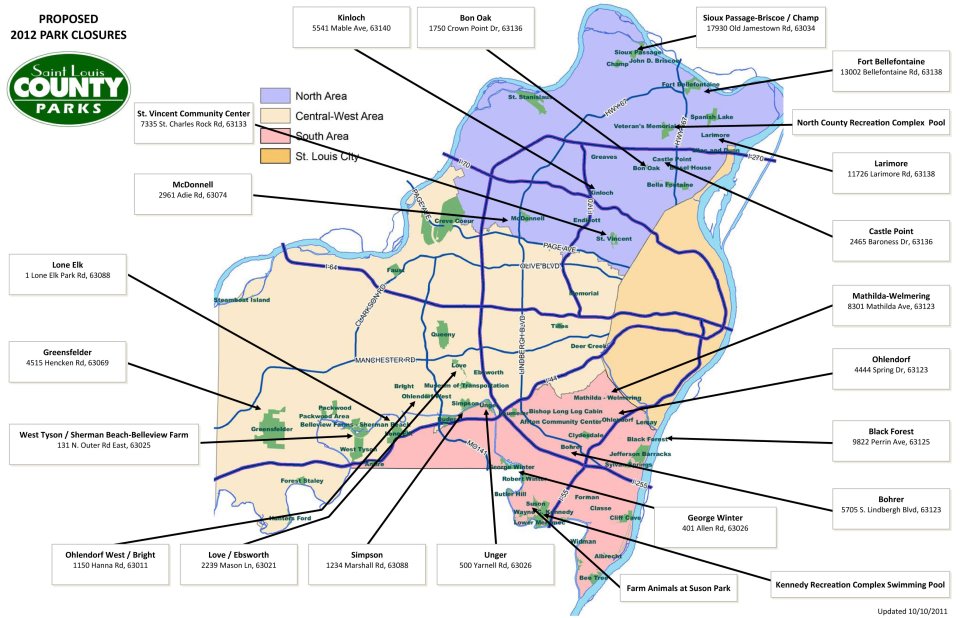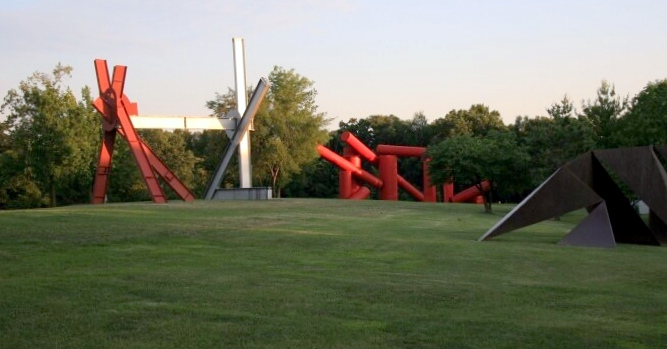 St. Louis County Executive Charlie Dooley is calling for the closure of three County parks and reduced services at many others, as well as many other reductions in a desperate attempt to close a growing budget hole. The services offered by St. Louis County are unsustainable. Whether it's national economic conditions, or the fact that growth has leapfrogged St. Louis County to St. Charles County and elsewhere over the past decade, this represents another glimpse into a looming crisis.
St. Louis County Executive Charlie Dooley is calling for the closure of three County parks and reduced services at many others, as well as many other reductions in a desperate attempt to close a growing budget hole. The services offered by St. Louis County are unsustainable. Whether it's national economic conditions, or the fact that growth has leapfrogged St. Louis County to St. Charles County and elsewhere over the past decade, this represents another glimpse into a looming crisis.
Increasing suburban poverty, declining population, declining sales tax and property tax revenue… Dooley is correct that no one should be surprised at his proposed cuts, or the desperate situation county government finds itself in. For decades the growing County could look at the City of St. Louis and believe that the worst municipal challenges lay east of Skinker. This has always been false, but the truth must now be obvious to even the most obstinate anti-City, anti-regional voices.

On the chopping block this round: 175 County jobs, Lone Elk Park, home to bison and elk herds, George Winter Park, providing access to the Meramec River and Fort Bellefontaine, the oldest US military installation west of the Mississippi River. Various fees will increase, services at 23 additional parks will decrease, as well as other, unspecified services.
The financial savings of specific cuts are somewhat unclear. In his letter to the St. Louis County Council, Dooley proposes cutting the "General, Road & Bridge, and Parks" budget by $10M. This, he says, will produce a budget of $301M with anticipated revenues of $285M, the difference to be closed by use of the County's reserve fund. Dooley predicts equally difficult decisions in the coming years.
Individuals losing their jobs are a personal tragedy not to be marginalized. However, in this case, I think the future of the County's incredible park system may be the narrative that best reveals the current and future challenges to be faced. Parks represent a community's shared aspirations and values. Our St. Louis County Park system is a national treasure.
It's easy, and tempting, to think of St. Louis County as Ladue, Kirkwood, Clayton, and other well-heeled municipalities, but it's also Wellston, Normandy and a substantial area of unincorporated land. Anecdotes and spot successes aside, the County isn't healthy. But what's being done? The largest projects in the County in the last decade have been the $350M Page Avenue Extension, which makes it easier for people to commute from St. Charles County, and the $525M New I-64, also making it easier for people to make longer commutes. Neither serve to grow St. Louis County today or in the future. The County will most likely lose residents this decade.
Whether the region will learn to cooperate and confront common challenges is becoming an every-more timely question. The latest study commissioned by St. Louis County is yet another stark warning. The St. Louis Region will either drift towards being another Kansas City (for all its charm, not a thriving city of tomorrow), or Minneapolis (a town that is emerging as an economic power center).
 I've lived in the City of St. Louis and University City (St. Louis Couty). I visit Lone Elk Park several times a year. I visit the St. Louis Zoo and Art Museum as well as other City parks. Those two institutions, along with the Missouri History Museum, St. Louis Science Center and Missouri Botanical Garden are part of the Zoo-Museum Taxing District (ZMD) comprised of the City of St. Louis and St. Louis County. Established more than 40 years ago (the Botanical Garden was added in 1983 and the History Museum in 1988). By 2008, the resulting funding produced by the ZMD reached $72M annually.
I've lived in the City of St. Louis and University City (St. Louis Couty). I visit Lone Elk Park several times a year. I visit the St. Louis Zoo and Art Museum as well as other City parks. Those two institutions, along with the Missouri History Museum, St. Louis Science Center and Missouri Botanical Garden are part of the Zoo-Museum Taxing District (ZMD) comprised of the City of St. Louis and St. Louis County. Established more than 40 years ago (the Botanical Garden was added in 1983 and the History Museum in 1988). By 2008, the resulting funding produced by the ZMD reached $72M annually.
The ZMD is showing its age. In a metropolitan region of nearly 2.8M residents, fewer than half now reside in the ZMD. If the City and County could have the foresight to collaborate on the funding of our most cherished cultural institutions in 1969, why shouldn't our region come together and fund regional assets? The twelve-county MSA is bound to sink or swim as one. Why not start with parks?
If collaboration cannot be found, we'll indefinitely experience what we face today: never-ending musical chairs of new growth followed by expansion of cultural amenities, followed by decline and the closing of those same assets. Not only are poverty and other social ills greatly expanding in until-now largely (mentally) insulated suburbia, growth in once booming St. Charles County has ground to a halt.
St. Charles may be proud of it's place on the list as one of only 19 counties in the US with poverty rate of less than 5% and its own executive may smile and attribute such a number to responsible citizens, but demographics are already changing and another decade of 27% population growth is a pipe dream. Some day the idea of a St. Charles County and City of St. Louis merger may be more than an April Fool's ruse.
Increasingly, the future of parks (not to mention schools and other community assets) is tied to private fundraising. This appears to be rather benign so far. So the community wants to raise funds to repair and enhance Forest Park? Great! Tower Grove Park is managed by a private group of donors and advocates. Laumeier Sculpture Park, the Museum of Transportation? Wonderful privately funded places. Parks need advocates. The problem is that our community becomes a reflection of the values of regional wealth, of those who can raise and give money.

{Laumeier Sculpture Park suceeds by attracting private support}

{the Museum of Transportation's associated 501(c)3 will increasingly be relied upon}
But we, as a society, lose when our remaining cultural assets are privately funded. Over time these assets become more and more private. Even the idea that private fundraising would free up municipal funds that could then be shifted to truly public parks without private support has proved elusive in times of shrinking budgets.
 The City is likely to soon pass a bill that would issue $64M in bonds to fund upgrades in city parks. Fully $30M would be allocated to Forest Park with the purpose being to lead the way for a $100M private Forest Park fundraising campaign. The private Forest Park Forever Foundation would buy the bonds and donate payments to the City from its own fundraising. The remaining $34M would be split among the city's other 108 parks and existing funding would largely be used to pay down the bonds. Is this a model for St. Louis County, or a temporary, short-sighted "fix"?
The City is likely to soon pass a bill that would issue $64M in bonds to fund upgrades in city parks. Fully $30M would be allocated to Forest Park with the purpose being to lead the way for a $100M private Forest Park fundraising campaign. The private Forest Park Forever Foundation would buy the bonds and donate payments to the City from its own fundraising. The remaining $34M would be split among the city's other 108 parks and existing funding would largely be used to pay down the bonds. Is this a model for St. Louis County, or a temporary, short-sighted "fix"?
I've long been an opponent of charging anyone to visit our free zoo, science center, art and history museums. Perhaps charging anyone in the region outside the current ZMD would be provide the leverage needed to expand the taxing district to reflect post-1969 reality. It's only a means to an end and getting to that end, the sharing the cost of our regional assets, by just about any other means would be preferred.
The future of St. Louis is one of fewer parks (and/or fewer amenities within) and much greater reliance on private funding. Unfortunately there is a vast disconnect between this reality and the minds of many urbanists. A project titled "Redfields to Greenfields" is currently exploring turning vast amounts of vacant commercial space in places such as Cleveland and Houston into parks. The idea being that vacant commercial real estate is a drag on adjacent property and a lack of demand means it's likely to remain vacant. Yet, how would a city possibly fund more parkland? St. Louis is quickly and happily turning over park land to private funds (see City Garden). Perhaps we would all be better served by more focus on providing regional stability for our existing parks as the fate of our St. Louis County Parks will likely tell us all we need to know about regional cooperation and economic health.
Patch.com has posted an updated story (even referencing this article) with more information. It appears that up to 19 total parks may be slated for closure and of the 175 County jobs to be cut, 135 would be from the Department of Parks and Recreation. According to Patch, "Residents will be able to comment on the proposed budget at the first public budget hearing immediately after the County Council meeting on Nov. 15 at 41 S. Central Ave., Clayton. County Council meetings usually end at about 6:30 p.m."
According to the St. Louis Post-Dispatch story, St. Louis County would seek to transfer parks, and their operating costs to the state of Missouri or to local municipalities. The County has yet to contact either to discuss this possibility. One strategy may be to "land bank" some parks and seek to reopen them "when money is found".
Want to know what's so special about places like Lone Elk Park? Check out these two home videos I shot recently – the park is an incredible asset to our region!
St. Louis County Executive Charlie Dooley 2012 Budget Letter


